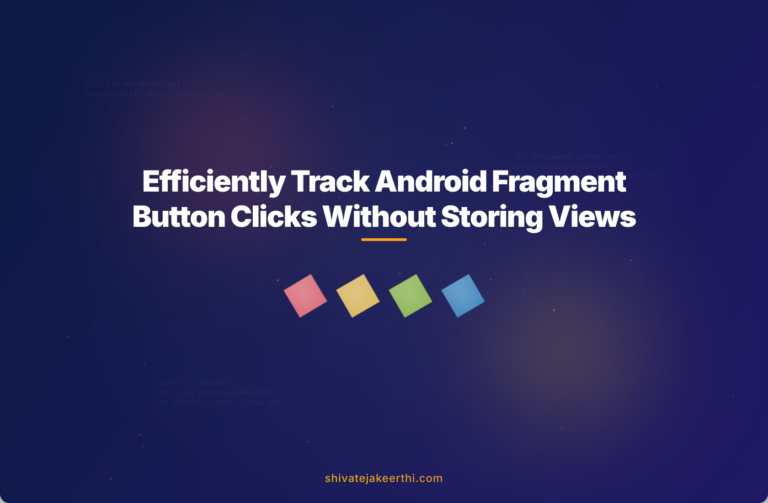Tracking button clicks within Android fragments can get tricky, especially if you’re trying to avoid storing large lists of view references. Storing view lists, although straightforward initially, becomes problematic over time—especially in apps with complex interfaces or multiple screen updates. Thankfully, there’s an easier, cleaner way. Let’s break down a much smarter approach to achieving effective button click tracking without storing cumbersome view lists.
Understanding the MainActivity Class
In most Android apps, everything revolves around your MainActivity: it’s the central hub, managing user interactions and navigation among various fragments. Think of MainActivity like the conductor of an orchestra—it’s responsible for organizing and synchronizing various components (the fragments) to deliver a smooth user experience.
Typically, MainActivity uses FragmentManager to switch between fragments and manage their states. While fragments handle their UI layout directly, button interaction events often bubble up to the MainActivity or other components for further logic handling—say, logging, analytics, or navigation actions.
Implementing OnClickListeners on Buttons
When working with fragments, developers often set up button clicks via the View.OnClickListener interface. It looks something like this:
Button myButton = fragmentView.findViewById(R.id.my_button);
myButton.setOnClickListener(new View.OnClickListener() {
@Override
public void onClick(View view) {
// handle button click
}
});
You might choose to handle button clicks directly in your fragment—for simple actions that’s perfectly okay. But what about when you need consistent tracking, logging, or analytics for multiple buttons across different fragments? Here, complexity grows quickly, often leading developers to inefficient solutions like storing view references in lists.
Challenges in Tracking Button Clicks
Storing UI views in a list might initially seem intuitive. After all, you can iterate through this list later to easily set listeners, track events, or perform repetitive tasks. However, this approach has clear limitations:
- Memory Usage and Performance Issues: Excessive references can cause memory leaks, potentially slowing down your application considerably.
- Difficult Maintenance: Changes to your app’s UI often require manually updating stored lists, increasing the potential for errors and bugs.
- Reduced Scalability: Larger or evolving apps face difficulties when managing lengthy arrays of UI components.
Clearly, maintaining button tracking using stored references is neither efficient nor scalable. So, what’s the way forward?
Exploring Alternative Solutions
Browsing through community solutions on forums like Stack Overflow, you’ll see suggestions like using Activity callbacks, interface-based logging strategies, or relying on third-party analytics tools (e.g. Firebase Analytics).
While these strategies work, each has some concerns:
- Callback Interfaces: Tend to clutter activities or fragments with boilerplate callbacks, complicating code readability.
- Third-Party Analytics: Effective but sometimes heavyweight or unnecessary for basic click-tracking purposes.
So, ideally, we want something simple, lightweight, and easily maintainable without needing external libraries or complicating the architecture.
Introducing a New Approach
A clean, manageable way of tracking button clicks without saving references is using a centralized listener pattern—create a single, reusable click listener object that automatically records button interactions efficiently. You set a universal tag or identifier in XML and handle all button clicks through a single listener setup.
Here’s why this solution works so well:
- No view reference lists required, eliminating risk of memory leaks or complicated management.
- Easily scalable for large apps with dynamic content.
- Easy to maintain and extend without cluttering your fragment or activity.
Implementing the New Approach
Let’s see exactly how you can apply this new solution step-by-step in your Android fragment:
Step 1: Setup Your XML layout
Assign identifying tags or IDs consistently to buttons within fragment layouts:
<Button
android:id="@+id/button_submit"
android:tag="submit_button"
android:layout_width="wrap_content"
android:layout_height="wrap_content"
android:text="Submit" />
Step 2: Create a Centralized Listener Class
Instead of storing multiple button instances, create a centralized listener that can handle clicks for all your buttons. Here’s an example listener:
public class CentralizedClickListener implements View.OnClickListener {
private AnalyticsTracker tracker;
public CentralizedClickListener(AnalyticsTracker tracker) {
this.tracker = tracker;
}
@Override
public void onClick(View v) {
String buttonTag = (String) v.getTag();
if (buttonTag != null) {
tracker.trackButtonClick(buttonTag);
}
// Additional shared functionality can be added here
}
}
Step 3: Implement the Listener in Your Fragment
Inside your Fragment’s lifecycle methods like onViewCreated, assign the centralized listener to your buttons:
@Override
public void onViewCreated(View view, Bundle savedInstanceState) {
super.onViewCreated(view, savedInstanceState);
AnalyticsTracker analytics = new AnalyticsTracker(requireContext());
CentralizedClickListener listener = new CentralizedClickListener(analytics);
view.findViewById(R.id.button_submit).setOnClickListener(listener);
view.findViewById(R.id.button_cancel).setOnClickListener(listener);
}
Now, each button click gets captured neatly and tracked centrally without messy lists or extra interfaces cluttering your fragment code.
Testing and Validating the Solution
Once you’ve implemented your centralized listener, ensure thorough validation. Easy tests include simulated clicks via instrumentation tests or simple manual validation. Use logging or debug outputs to confirm your click listener consistently captures events correctly.
Tools such as Espresso can automate such tests effectively, saving time and ensuring that the tracking mechanism works as expected under various conditions.
Comparing the New Approach with Existing Methods
Let’s quickly summarize how this centralized method stacks up against traditional methods such as storing views in lists:
| Criterion | Storing View Lists | Centralized Click Listener |
| Memory Efficiency | Poor. Higher chance of memory leaks. | Excellent. Minimal overhead. |
| Maintainability | difficult as the app scales | High. Easy-to-extend approach. |
| Scalability | Limited scalability when faced with frequent UI changes | High scalability, effortlessly adapts to evolving UI |
Clearly, the centralized click listener strategy emerges as a superior alternative for maintaining robust, scalable button-tracking capability in Android fragments.
Tracking button clicks shouldn’t become a roadblock in Android app development. By embracing a centralized listener pattern, you move closer towards cleaner, more efficient fragment management without resorting to clunky lists or third-party clutter.
Want to optimize other development tasks like this one? Check out more handy tips and solutions on our dedicated JavaScript articles page, where you’ll find practical insights to improve your coding efficiency. Also, don’t hesitate to share your experiences or questions—how have you handled button click tracking in your fragments? Feel free to comment and let me know!



0 Comments